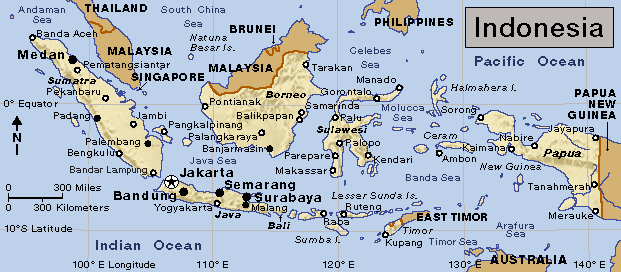Semarang (pop. 1,653,524) is the capital and largest city of the Indonesian province of Central Java. It is also Central Java’s main port.

The city.
Semarang stands near the northern coast of Central Java. The city occupies the narrow coastal plain between the Java Sea and Mount Ungaran. About half of Semarang lies on a swampy region near the harbor. The rest stands on the foothills of Mount Ungaran to the south. The area around the harbor is extremely hot and humid. It sometimes records the highest temperature in all of Indonesia. Candi, the southern part of the city, receives cooling breezes from the Java Sea and has a more temperate climate.
When strong monsoon winds blow, Semarang’s harbor can be dangerous. In the past, it provided little protection for ships. There was substantial development at the harbor during the 1980’s. A long breakwater, completed in 1985, enabled the port to operate year-round. Tanjung Mas, the port at Semarang, is now one of the largest Indonesian ports in terms of goods handled.
Semarang’s main residential suburb is Candi. It has many beautiful houses and bungalows built along winding streets that follow the pattern of the hills. The view from Candi takes in the lower part of the city and the Java Sea. To the west of Candi is Candi Baru (New Candi), a modern residential suburb.
Places of interest include Taman Hiburan Rakyat, where there is a unique snake park. There are also many interesting Hindu-Javanese temples in the districts around Semarang. The most popular tourist attractions are the Chinatown district and the Sam Po Kong temple near the airport. Local Chinese believe the temple to be the burial place of Zheng He (also spelled Cheng Ho), an admiral in the Imperial Chinese Navy during the 1400’s.
People.
The province of Central Java is one of the most densely populated parts of Indonesia. The Indonesian government has moved many people to other parts of Indonesia to ease the pressure of population in Central Java.
Semarang is a major center through which people pass before resettling in southern Sumatra, Kalimantan, or Papua. Semarang is mainly a trade and industrial center. The State University of Diponegoro opened in 1960. But unlike many provincial capitals, Semarang has never been an educational or cultural center.
Economy.
The port of Semarang handles nearly all the imports coming into Central Java. The main exports include cloves, jute, kapok, pepper, sugar, teak, and tobacco.
Semarang has no heavy industry, but it has factories that make glassware, umbrellas, and weighing instruments. Factories in the surrounding areas produce textiles. The city is famous in Indonesia for its tobacco products. These include cut tobacco, ordinary cigarettes, and Indonesian kretek cigarettes, which contain cloves and burn with a crackling noise. Semarang is a major trading center for Central Java and has several large shopping districts. Roads and railroads link Semarang with all the main cities of Java. Airlines connect Kali Banteng Airport, 71/2 miles (12 kilometers) west of Semarang, with Jakarta, Yogyakarta, and Surabaya.
History.
According to local legend, the ship of the Chinese admiral Cheng Ho sank off Japara, north of Semarang, in 1433. The Chinese erected the Sam Po Kong temple in his honor and placed inside an anchor believed to have come from his ship. The town of Demak, 16 miles (25 kilometers) east of Semarang, was the center of the Muslim kingdom of Demak, which lasted from 1500 to 1546. The town has the oldest and most venerated mosque in Indonesia. People believe that the mosque was built by the Wali Sanga, the nine Muslim teachers who spread Islam throughout Java.
